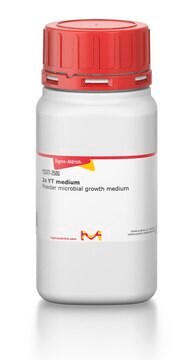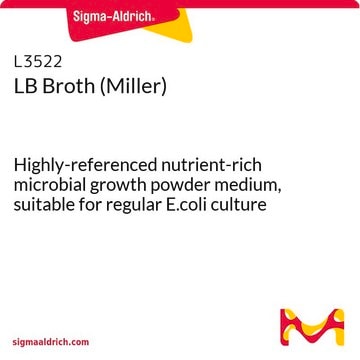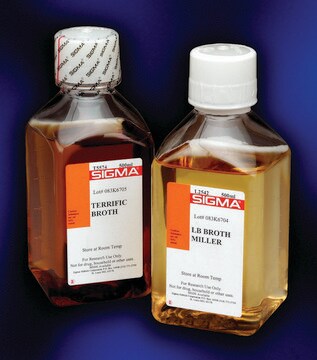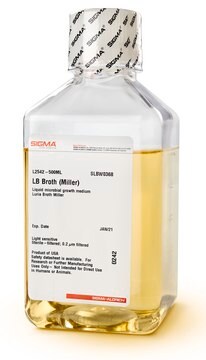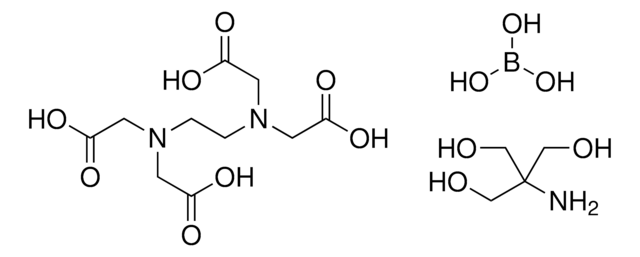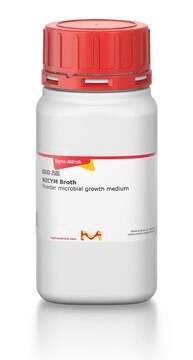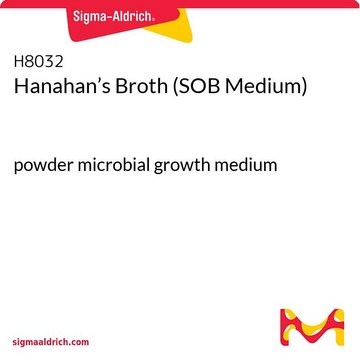Alle Fotos(2)
Wichtige Dokumente
T9179
Terrific-Bouillon
EZMix powder microbial growth medium
Synonym(e):
TB media
Anmeldenzur Ansicht organisationsspezifischer und vertraglich vereinbarter Preise
Alle Fotos(2)
About This Item
UNSPSC-Code:
41106200
NACRES:
NA.85
Empfohlene Produkte
Qualität
Molecular Biology
for molecular biology
Qualitätsniveau
Beschreibung
TB; quick dissolve, dust-free formulation
Sterilität
non-sterile
Form
powder
Methode(n)
microbiological culture: suitable
Anwendung(en)
agriculture
food and beverages
microbiology
Lagertemp.
room temp
Eignung
nonselective for Escherichia coli
nonselective for coliforms
Allgemeine Beschreibung
Terrific Broth ist ein gerne empfohlenes Wachstumsmedium für Mikroben, das auch für die Kultivierung von E. coli verwendet wird. Die nährstoffreiche mikrobielle Bouillon enthält Glycerin, Peptide, Aminosäuren, wasserlösliche Vitamine und Kohlenhydrate.
Anwendung
Geeignet für die nicht selektive Kultivierung von E. coli-Stämmen für das Klonen, eine DNA-Plasmidproduktion mit hoher Ausbeute und die hochergiebige Produktion rekombinanter Proteine. Auch geeignet für die selektive Kultivierung, wenn entsprechende Antibiotika hinzugefügt werden.
Terrific Broth wird eingesetzt:
Terrific Broth wird eingesetzt:
- als Medium für das selektive Wachstum von E.coli BL21 (DE3) V2RpRARE, das eine MLL SET (nukleäres Protoonkogen)-Domäne in pET28GST-LIC exprimiert
- zur Kultivierung von BL21(DE3)-Zellen, die Plasmid enthalten, das IL-8 (Interleukin-8) exprimiert
- Terrific Broth ist auch geeignet zur Verwendung in Bakteriensuspensionen (Bacillus subtilis-Stamm 1085B)
Leistungsmerkmale und Vorteile
Terrific Broth EZMix Pulver bietet:
- Granuliertes, staubfreies Format für sicherere Handhabung und schnelleres Mischen
- Kostengünstige Alternative zu Flüssigkeit
- Modifizierte Formulierung (ohne Glycerin)
- Einfaches Hochskalieren durch Verwenden größerer Packungen
Komponenten
*Bitte beachten Sie, dass manche verfügbaren Produktgrößen in Flüssigkeitsmaßen angegeben sind. Dies ist ein Produkt in Pulverform, und diese Größenangaben bezeichnen das rekonstituierte Endvolumen.
23,6 g/L Hefeextrakt
11,8 g/L Trypton
9,4 g/L K2HPO4
2,2 g/L KH2PO4
23,6 g/L Hefeextrakt
11,8 g/L Trypton
9,4 g/L K2HPO4
2,2 g/L KH2PO4
Rekonstituierung
Zur Herstellung von 500 mL 24,1 g Pulver und 4 mL Glycerin in ausreichend entionisiertem Wasser suspendieren. Zur Sterilisierung 15 Minuten bei 121 °C autoklavieren. Bei Bedarf vor der Zugabe weiterer Stoffe, z. B. Antibiotika, abkühlen lassen.
Rechtliche Hinweise
Ähnliches Produkt
Produkt-Nr.
Beschreibung
Preisangaben
Lagerklassenschlüssel
11 - Combustible Solids
WGK
WGK 3
Flammpunkt (°F)
Not applicable
Flammpunkt (°C)
Not applicable
Hier finden Sie alle aktuellen Versionen:
Besitzen Sie dieses Produkt bereits?
In der Dokumentenbibliothek finden Sie die Dokumentation zu den Produkten, die Sie kürzlich erworben haben.
Kunden haben sich ebenfalls angesehen
Eve Toulza et al.
Applied and environmental microbiology, 76(13), 4521-4529 (2010-05-04)
Understanding the conditions leading to harmful algal blooms, especially those produced by toxic dinoflagellate species, is important for environmental and health safety. In addition to investigations into the environmental conditions necessary for the formation of toxic blooms, we postulate that
Idan Tuval et al.
Proceedings of the National Academy of Sciences of the United States of America, 102(7), 2277-2282 (2005-02-09)
Aerobic bacteria often live in thin fluid layers near solid-air-water contact lines, in which the biology of chemotaxis, metabolism, and cell-cell signaling is intimately connected to the physics of buoyancy, diffusion, and mixing. Using the geometry of a sessile drop
Paul Peluso et al.
Analytical biochemistry, 312(2), 113-124 (2003-01-18)
Antibody microarrays have the potential to revolutionize protein expression profiling. The intensity of specific signal produced on a feature of such an array is related to the amount of analyte that is captured from the biological mixture by the immobilized
Optimizing antibody immobilization strategies for the construction of protein microarrays
Peluso P, et al.
Analytical Biochemistry, 312(2), 113-124 (2003)
Cynthia Sanville Millard et al.
Protein expression and purification, 29(2), 311-320 (2003-05-28)
Contemporary approaches to biology often call for the high-throughput production of large amounts of numerous proteins for structural or functional studies. Even with the highly efficient protein expression systems developed in Escherichia coli, production of these proteins is laborious and
Unser Team von Wissenschaftlern verfügt über Erfahrung in allen Forschungsbereichen einschließlich Life Science, Materialwissenschaften, chemischer Synthese, Chromatographie, Analytik und vielen mehr..
Setzen Sie sich mit dem technischen Dienst in Verbindung.


